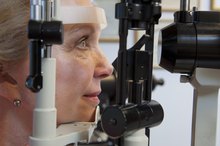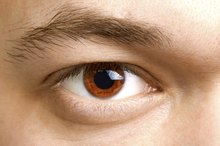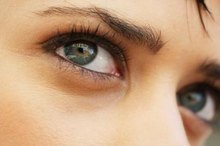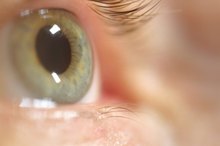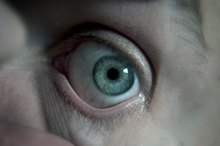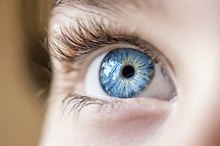High Cholesterol Effects on Eyes
High cholesterol, or hyperlipidemia, is characterized by the presence in the bloodstream of abnormally high total cholesterol -- combined high-density lipoprotein, or HDL, and low-density lipoprotein -- LDL, abnormally high LDL -- bad cholesterol, and/or abnormally high triglycerides. This condition can have adverse affects on your eyes, causing corneal arcus, retinal vein occlusion and xanthomas.
Corneal Arcus
Whitish, gray or yellowish deposits around the circumference of the cornea are associated with high cholesterol, particularly among those individuals with extremely high levels of cholesterol and those with familial hyperlipidemia (an inherited predisposition toward high cholesterol and high blood triglycerides). Called a corneal arcus, this ring appearing around the iris has also been shown to be related to diabetes and high blood pressure, so further testing is needed to determine the underlying health condition when a corneal arcus is spotted. Its prevalence increases with age, and it is more common among men than women. A corneal arcus does not usually affect vision, and treatment is typically focused on controlling cholesterol.
- Whitish, gray or yellowish deposits around the circumference of the cornea are associated with high cholesterol, particularly among those individuals with extremely high levels of cholesterol and those with familial hyperlipidemia (an inherited predisposition toward high cholesterol and high blood triglycerides).
- A corneal arcus does not usually affect vision, and treatment is typically focused on controlling cholesterol.
Retinal Vein Occlusion
Does High Cholesterol Cause Hair Loss?
Learn More
Vascular disease of the eye is a concern in individuals with high cholesterol. Cholesterol lines the blood vessels in the eye just as it lines the blood vessels in other parts of the body. When cholesterol buildup reaches a certain level, a blockage in a blood vessel from the retina can occur. This blood clot may cut off blood supply to parts of the eye or may burst, ultimately leading to loss of vision in the affected eye(s). Usually, symptoms of retinal vein occlusion happen acutely with patients experiencing a sudden blurring or partial or total loss of vision. Treatments for retinal vein occlusion include aspirin and laser treatments 1. Outcomes will vary by case, but in many instances, some vision can be restored.
- Vascular disease of the eye is a concern in individuals with high cholesterol.
- This blood clot may cut off blood supply to parts of the eye or may burst, ultimately leading to loss of vision in the affected eye(s).
Xanthomas
Xanthomas are fatty deposits beneath the skin that produce soft, yellowish bumps on the skin’s surface. They may occur around the eye and in other parts of the body, as well, including the elbows, joints, tendons, knees and buttocks. While not contagious or harmful in and of themselves, they can be disfiguring and are a sign of a more serious underlying medical problem related to elevated blood lipids. Occasionally, xanthomas may burst (called eruptive xanthomas ), at which time medical attention should immediately be sought.
- Xanthomas are fatty deposits beneath the skin that produce soft, yellowish bumps on the skin’s surface.
- Occasionally, xanthomas may burst (called eruptive xanthomas ), at which time medical attention should immediately be sought.
Related Articles
References
- Progress in Retinal and Eye Research: Acute Retinal Arterial Occlusion Disorders
- Lipids in Health and Disease: Correlating Corneal Arcus with Atherosclerosis in Familial Hypercholesterolemia
- Indian Journal of Ophthamology: Corneal Arcus and Xanthomas in Homozygous Familial Hypercholesterolemia -- First Report From China
- Ang M, Wong W, Park J, et al. Corneal arcus is a sign of cardiovascular disease, even in low-risk persons. Am J Ophthalmol. 2011;152(5):864-71.e1. doi:10.1016/j.ajo.2011.04.014
- Moosavi M, Sareshtedar A, Zarei-Ghanavati S, Zarei-Ghanavati M, Ramezanfar N. Risk factors for senile corneal arcus in patients with acute myocardial infarction. J Ophthalmic Vis Res. 2010;5(4):228–231.
- Fernández A, Sorokin A, Thompson PD. Corneal arcus as coronary artery disease risk factor. Atherosclerosis. 2007;193(2):235-40. doi:10.1016/j.atherosclerosis.2006.08.060
- Fernandez AB, Keyes MJ, Pencina M, D'Agostino R, O'Donnell CJ, Thompson PD. Relation of corneal arcus to cardiovascular disease (from the Framingham Heart Study data set). Am J Cardiol. 2009;103(1):64–66. doi:10.1016/j.amjcard.2008.08.030
- American Academy of Ophthalmology. Why Are My Eyes Changing Color? Updated Feb. 28, 2019.
Writer Bio
Based in New York City, Tricia Mangan began her writing career in 2001. She has co-authored a National Cancer Institute report and a number of research articles that have appeared in medical journals. Tricia holds a Master of Arts in clinical psychology from Stony Brook University and boasts diverse clinical, research and teaching experience.


